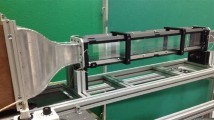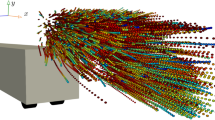Abstract
A 3-D time-resolving and whole-volume Digital-Particle-Image-Velocimetry (DPIV) technique based on the concept of a scanning light-sheet is presented and applied here to the 3-D transient wake phenomena in the spherical cap wake flow. The technique uses a scanning light-sheet for rapid sampling of the flow in depth and a two-camera recording system for stereoscopic 3-D DPIV. Application of a correlation technique in combination with a calibration yields, aside from the correct in-plane displacement, also the out of plane component and thus the total velocity vectors within the planes of the scanning light-sheet. With a high scanning rate in comparison to the characteristic time scales the method provides the 3-D velocity field in space and time. Through the use of conventional video-techniques the temporal evolution of the complete velocity and vorticity field can be obtained quantitatively from experiments. This is demonstrated for the 3-D starting flow around a spherical cap at Re=300. During the starting process, the flow in the wake evolves into a spherical vortex ring where the velocity distribution is very close to the theoretical solution of the Hill-type vortex. Later on, the Hill-type vortex ring deforms and the flow changes from a rotational symmetric stage to a planar symmetric flow with a double-threaded vortical structure which consists of two counter-rotating streamwise vortices similar to the ones observed in sphere wake flow.
Similar content being viewed by others
References
Meng, H. and Hussain, F., Holographic particle image velocimetry: A 3D measurment technique for vortex interactions, coherent structures and turbulence.Fluid Dynamic Research 8 (1991) 33–52.
Adrian, R.J., Particle-imaging techniques for experimental fluid mechanics,Ann. Rev. Fluid Mech. 23 (1991) 261–304.
Hinsch, K., Three-dimensional particle velocimetry.Measuring Science and Technology 6(6) (1995) 742–753.
Sinha, S.K. and Kuhlman, P.S., Investigating the use of stereoscopic particle streak velocimetry for estimating the three-dimensional vorticity field.Experiments in Fluids 12 (1992) 377–384.
Brücker, Ch., Dreidimensionale quantitative Vermessung des Wirbelaufplatzens mit der Particle-Tracking-Velocimetry (PTV) kombiniert mit Lichtschnitt-Scanning. DGLR-Rep. 92 (1992) pp. 445–454.
Brücker, Ch. and Althaus, W., Study of vortex breakdown by particle tracking velocimetry (PTV). Part 1: Bubble-type vortex breakdown.Experiments in Fluids 13 (1992) 339–349.
Brücker, Ch., Digital Particle Image Velocimetry (DPIV) in a scanning light-sheet: 3-D starting flow around a short cylinder,Experiments in Fluids 19(4) (1995) 371–380.
Kimura, I. and Kohno, Y., Measurement of three-dimensional velocity vectors in a flow field based on spatio-temporal image correlation. In:FLUCOME 91 (1991) pp. 609–615.
Raffel, M., Gharib, M., Ronneberger, O. and Kompenhans, J., Feasibility study of three-dimensional PIV by correlating images of particles within paralle light sheet planes.Experiments in Fluids 19(2) (1995) 69–77.
Brücker, Ch., A new method for determination of the out-of-plane component in 3-D PIV using a color-coded light-sheet and spatial correlation: Simulation and feasibility study for 3-D Scanning PIV. In: Conference Trans.Optical Methods and Data Processing in Heat and Fluid Flow, City Univ. London, 18–19 April (1996) pp. 189–200.
Gauthier, V. and Riethmuller, M.L., Application of PIDV to complex flows: Measurement of the third component. In:Particle Image Displacement Velocimetry, VKI Lect. Ser. 1988–06, Belgium, March 21–25 (1988), pp. 1–24.
Prasad, A.K. and Adrian, R.J., Stereoscopic particle image velocimetry applied to liquid flows.Experiments in Fluids 15 (1993) 49–60.
Westerweel, J. and Nieuwstadt, F.T.M., Performance tests on 3-dimensional velocity measurements with a two-camera digital particle-image-velocimeter. In:ASME Conference Laser Anemometry, Vol. 1 (1991) pp. 349–355.
Brücker, Ch., Study of the 3-D flow in a T-Junction using a Dual-Scanning method for 3-D Scanning-Particle-Image-Velocimetry (3-D SPIV). In:Proc. 10th Symp. Turbulent Shear Flows, Penn State University, 14–16 August (1995) pp. (7–19)–(7–24).
Adamczyk, A.A. and Rimai, L., Reconstruction of a 3-dimensional flow field from orthogonal views of seed track video images.Experiments in Fluids 6 (1988) 380–386.
Coppus, J.H.C., Rietema, K. and Ottengraf, S.P.P., Wake phenomena behind spherical-cap bubbles and solid spherical-cap bodies.Transaction Instn. Chemical. Engineers 55 (1977) 122–129.
Wegener, P.P. and Parlange, J.Y., Sperical-cap bubbles.Annual Review Fluid Mechanics 5 (1973) 79–100.
Magarvey, R.H. and MacLatchy, C.S., Vortices in sphere wakes.Canadian Journal Physics 43 (1965) 1649–1656.
Willert, C. and Gharib, M., Digital Particle Image Velocimetry.Experiments in Fluids 10 (1991) 181–1943.
Hnat, J.G. and Buckmaster, J.D., Spherical cap bubbles and skirt formation.Physics of Fluids 19(2) (1976) 182–194.
Batchelor, G.K.,An Introduction to Fluid Mechanics. Cambridge: Cambridge University Press (1967).
Viets, H., Accelerating sphere-wake interaction.AIAA J. 9(10) (1971) 2087–2089.
Magarvey, R.H. and Bishop, R.L., Transition ranges for three-dimensional wakes.Canadian Journal Physics 39 (1961) 1418–1422.
Author information
Authors and Affiliations
Rights and permissions
About this article
Cite this article
Brücker, C. 3-D scanning-particle-image-velocimetry: Technique and application to a spherical cap wake flow. Appl. Sci. Res. 56, 157–179 (1996). https://doi.org/10.1007/BF02249379
Received:
Revised:
Issue Date:
DOI: https://doi.org/10.1007/BF02249379




